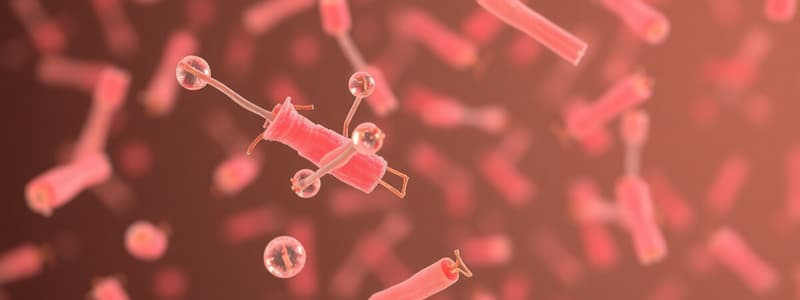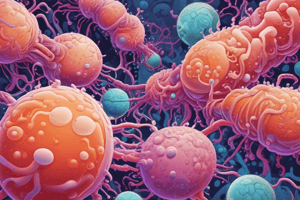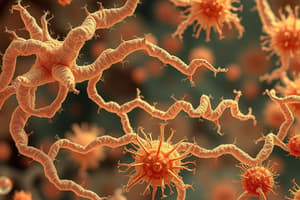Podcast
Questions and Answers
Which classification method is used for identifying Streptococcus species based on carbohydrate antigens?
Which classification method is used for identifying Streptococcus species based on carbohydrate antigens?
- Alpha and Beta Hemolytic Patterns
- Lancefield Grouping (correct)
- Gram Staining Techniques
- Morphological Structure
What type of hemolysis is characterized by complete breakdown of red blood cells?
What type of hemolysis is characterized by complete breakdown of red blood cells?
- Gamma (γ) Hemolysis
- Beta (β) Hemolysis (correct)
- Epsilon (ε) Hemolysis
- Alpha (α) Hemolysis
Which characteristic is NOT a feature of Streptococcus bacteria?
Which characteristic is NOT a feature of Streptococcus bacteria?
- Facultative anaerobes
- Catalase positive (correct)
- Capable of fermenting carbohydrates
- Gram-positive cocci
What is a common nutritional requirement for Streptococcus bacteria?
What is a common nutritional requirement for Streptococcus bacteria?
Which disease is primarily associated with Streptococcus pyogenes?
Which disease is primarily associated with Streptococcus pyogenes?
Which statement correctly describes the treatment challenges associated with Enterococcus infections?
Which statement correctly describes the treatment challenges associated with Enterococcus infections?
What is a common clinical disease associated with Enterococcus in hospitalized patients?
What is a common clinical disease associated with Enterococcus in hospitalized patients?
Which characteristic is true for Enterococcus as a pathogen?
Which characteristic is true for Enterococcus as a pathogen?
What are the implications of Enterococcus's antibiotic resistance?
What are the implications of Enterococcus's antibiotic resistance?
Which of the following best describes the epidemiological habit of Enterococcus?
Which of the following best describes the epidemiological habit of Enterococcus?
What type of infections can Enterococcus (particularly in compromised hosts) lead to?
What type of infections can Enterococcus (particularly in compromised hosts) lead to?
Which classification does Enterococcus belong to based on its Lancefield antigen?
Which classification does Enterococcus belong to based on its Lancefield antigen?
What contributes to Enterococcus's role as a significant clinical challenge?
What contributes to Enterococcus's role as a significant clinical challenge?
What role does the capsule play in Streptococcus pneumoniae's virulence?
What role does the capsule play in Streptococcus pneumoniae's virulence?
Which of the following diseases is most commonly associated with Streptococcus pyogenes?
Which of the following diseases is most commonly associated with Streptococcus pyogenes?
Which treatment is considered effective against Streptococcus pyogenes infections?
Which treatment is considered effective against Streptococcus pyogenes infections?
What is the primary characteristic of the 23-valent polysaccharide vaccine for Streptococcus pneumoniae?
What is the primary characteristic of the 23-valent polysaccharide vaccine for Streptococcus pneumoniae?
Streptococcus agalactiae is primarily a concern for which group?
Streptococcus agalactiae is primarily a concern for which group?
What are the two major forms of neonatal disease caused by Streptococcus agalactiae?
What are the two major forms of neonatal disease caused by Streptococcus agalactiae?
Which protein in Streptococcus pyogenes helps in preventing phagocytosis?
Which protein in Streptococcus pyogenes helps in preventing phagocytosis?
What characteristic allows Streptococcus pneumoniae to colonize and cause infections?
What characteristic allows Streptococcus pneumoniae to colonize and cause infections?
Which serious condition is caused by Streptococcus pyogenes and is characterized by high mortality rates?
Which serious condition is caused by Streptococcus pyogenes and is characterized by high mortality rates?
What is a significant concern regarding the treatment of Streptococcus pneumoniae?
What is a significant concern regarding the treatment of Streptococcus pneumoniae?
Flashcards
Gram-positive cocci
Gram-positive cocci
Bacteria that stain purple in Gram staining, and have a spherical shape.
Facultative anaerobes
Facultative anaerobes
Microorganisms that can survive with or without oxygen.
Lancefield Grouping
Lancefield Grouping
A method to classify Streptococcus based on carbohydrate antigens.
Beta Hemolysis
Beta Hemolysis
Signup and view all the flashcards
Alpha Hemolysis
Alpha Hemolysis
Signup and view all the flashcards
Enterococcus General Characteristics
Enterococcus General Characteristics
Signup and view all the flashcards
Enterococcus Classification
Enterococcus Classification
Signup and view all the flashcards
Enterococcus Virulence
Enterococcus Virulence
Signup and view all the flashcards
Enterococcus Antibiotic Resistance
Enterococcus Antibiotic Resistance
Signup and view all the flashcards
Enterococcus Epidemiology
Enterococcus Epidemiology
Signup and view all the flashcards
Enterococcus Clinical Diseases
Enterococcus Clinical Diseases
Signup and view all the flashcards
Enterococcus Treatment
Enterococcus Treatment
Signup and view all the flashcards
Enterococcus Resistance Transfer
Enterococcus Resistance Transfer
Signup and view all the flashcards
Streptococcus pyogenes (Group A Streptococcus) virulence factors
Streptococcus pyogenes (Group A Streptococcus) virulence factors
Signup and view all the flashcards
Streptococcus pneumoniae pathogenesis
Streptococcus pneumoniae pathogenesis
Signup and view all the flashcards
Streptococcus pneumoniae epidemiology
Streptococcus pneumoniae epidemiology
Signup and view all the flashcards
Group B Streptococcus (Streptococcus agalactiae) Transmission
Group B Streptococcus (Streptococcus agalactiae) Transmission
Signup and view all the flashcards
Group B Streptococcus pathogenesis
Group B Streptococcus pathogenesis
Signup and view all the flashcards
Streptococcus pneumoniae clinical diseases
Streptococcus pneumoniae clinical diseases
Signup and view all the flashcards
Streptococcus pyogenes clinical diseases
Streptococcus pyogenes clinical diseases
Signup and view all the flashcards
Viridans Streptococci characteristics
Viridans Streptococci characteristics
Signup and view all the flashcards
Streptococcus pneumoniae treatment
Streptococcus pneumoniae treatment
Signup and view all the flashcards
Streptococcus pyogenes treatment
Streptococcus pyogenes treatment
Signup and view all the flashcards
Study Notes
Streptococcus and Enterococcus Overview
- Streptococcus and Enterococcus are Gram-positive bacteria frequently causing human diseases.
- They share some characteristics, but also have unique attributes affecting their pathogenicity, clinical features, and treatments.
- This overview synthesizes information on classification, pathogenesis, epidemiology, clinical diseases, and control measures.
Streptococcus
1.1 General Characteristics
- Gram-positive cocci arranged in pairs or chains.
- Facultative anaerobes with complex nutritional needs.
- Catalase-negative, capable of fermenting carbohydrates.
1.2 Classification
- Lancefield grouping: based on carbohydrate antigens (e.g., Group A Streptococcus pyogenes).
- Hemolytic patterns:
- Beta (β) hemolysis: complete hemolysis (e.g., Streptococcus pyogenes).
- Alpha (α) hemolysis: incomplete hemolysis (e.g., Streptococcus pneumoniae).
- Gamma (γ) hemolysis: no hemolysis.
1.3 Streptococcus pyogenes (Group A Streptococcus)
1.3.1 Pathogenesis and Immunity
- Avoidance of Opsonization and Phagocytosis:
- Hyaluronic acid capsule: mimicking host tissues, evading immune detection.
- M protein: Prevents phagocytosis and aids in adhesion.
- Other proteins (F protein, lipoteichoic acids): function as adhesins.
- Toxins and Enzymes
- Streptolysin O and S: pore-forming toxins responsible for beta-hemolysis and cell lysis.
- Pyrogenic exotoxins (SpeA, SpeB): superantigens causing severe immune responses.
1.3.2 Clinical Diseases
- Pharyngitis: common bacterial cause.
- Scarlet fever: distinct rash caused by pyrogenic toxins.
- Skin infections: impetigo, erysipelas, necrotizing fasciitis.
- Streptococcal Toxic Shock Syndrome (STSS): severe systemic disease with high mortality.
1.3.3 Treatment and Control
- Penicillin remains effective, but prompt treatment is crucial to prevent complications like rheumatic fever and glomerulonephritis.
1.4 Streptococcus pneumoniae
1.4.1 Pathogenesis and Immunity
- Attachment Mechanisms
- Surface protein adhesins: facilitates adherence to host cells.
- Secretory IgA protease: cleaves IgA in mucosal surfaces.
- Pneumolysin: contributes to tissue damage and immune evasion.
- Capsule: Key virulence factor enabling phagocytic survival.
- Epidemiology
- Colonizes nasopharynx of healthy individuals, spreads to lungs, sinuses, and meninges
- Vaccine introduction reduced incidence.
- Clinical Diseases
- Pneumonia: abrupt onset, localized infection.
- Sinusitis and otitis media: often following viral infections.
- Meningitis and bacteremia: high morbidity and mortality rates, especially in vulnerable populations.
- Treatment and Control
- Penicillin resistance increasing, thus needing alternative treatments (e.g., fluoroquinolones, vancomycin combined with ceftriaxone).
1.5 Streptococcus agalactiae (Group B Streptococcus)
- Neonatal transmission: high colonization rates in infants born to colonized mothers.
- Clinical diseases:
- Neonatal diseases:
- Early-onset disease: bacteremia, pneumonia, or meningitis.
- Late-onset disease: primarily meningitis.
- Adult infections: bacteremia, endometritis (postpartum women), urinary tract infections.
- Neonatal diseases:
- Treatment and control: penicillin susceptibility screening, prophylactic antibiotics for preventing neonatal disease.
1.6 Viridans Streptococci
- Characteristics and epidemiology: comprise over 30 species/subspecies, part of normal flora.
- Pathogenic potential: can cause oral cavity diseases (e.g., dental caries), and systemic infections (e.g., endocarditis) especially in those with pre-existing heart conditions.
2. Enterococcus
2.1 General Characteristics
- Gram-positive cocci arranged in pairs or chains.
- Facultative anaerobes with complex nutritional requirements.
- Resistant to many environmental conditions (e.g., high salt concentrations, bile acids).
2.2 Classification
- Belong to group D in Lancefield classification based on a unique antigen.
2.3 Pathogenesis and Immunity
- Limited virulence factors, doesn't produce potent toxins but can cause illness in compromised hosts.
- Antibiotic resistance: significant clinical challenges due to reservoirs of resistance genes.
2.4 Epidemiology
- Normal enteric flora (gastrointestinal and genitourinary tracts).
- Nosocomial infections (commonly isolated from hospitalized patients' skin and respiratory tracts).
2.5 Clinical Diseases
- Urinary Tract Infections (UTIs), especially in catheterized patients.
- Endocarditis (involving intravascular catheters).
- Wound infections (often polymicrobial, also associated with other organisms).
2.6 Treatment and Control
- High antibiotic resistance (aminoglycosides, beta-lactams, vancomycin).
- Combination therapy often necessary (using aminoglycosides and cell wall-active agents).
Summary
- Understanding epidemiology, pathogenesis, clinical manifestations and control methods for Streptococcus and Enterococcus is essential for managing associated infections.
- High antibiotic resistance and the diverse range of infections caused necessitates ongoing research and adapting clinical practices to mitigate their impact on public health.
- Transfer of resistance (e.g., plasmid-encoded) is a significant concern.
Studying That Suits You
Use AI to generate personalized quizzes and flashcards to suit your learning preferences.
Related Documents
Description
This quiz provides a detailed overview of Streptococcus and Enterococcus, focusing on their characteristics, classification, and pathogenicity. It explores their epidemiology, clinical features, and control measures, highlighting essential information for understanding these Gram-positive bacteria. Perfect for students and professionals in microbiology and medicine.




